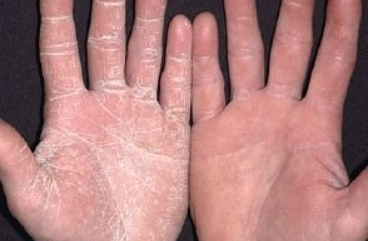Tinea Manuum - a superficial fungal infection of hands. ICD-10 code: B35.2
The most common causative agents of tinea manuum are the pathogenic fungi Trichophyton rubrum (90%). Less commonly, these diseases are caused by Epidermophyton floccosum and Candida species.
Infection with pathogenic fungi can occur through direct contact with an infected person, as well as through footwear, clothing, personal items (bathroom mats, sponges, nail care tools, etc.), visiting gyms, saunas, swimming pools. Skin abrasions, tears in the interdigital folds caused by friction, increased sweating or dryness of the skin, inadequate drying after water procedures, narrow interdigital spaces, vascular diseases in limbs, and other factors can facilitate fungal penetration of the skin.
Mycoses can become widespread, especially in the presence of coexisting conditions such as endocrine disorders, often diabetes, immune disorders, genodermatoses, blood disorders, and the use of antibiotics, corticosteroids, and cytostatic drugs.Tinea manuum is most commonly caused by Trichophyton rubrum, Trichophyton mentagrophytes, and Epidermophyton floccosum. Infection of the hands typically results from foci of tinea pedis due to autoinoculation; in rare cases, it may result from exogenous introduction of the fungi.
At onset, the disease is characterized by involvement of skin of the palms and is usually unilateral. It may be associated with onychomycosis. Clinical signs include dry skin, thickening of the stratum corneum, well-defined scaly patches with erythema, cornification, mucinous desquamation in the palmar creases, excessive skin wrinkles, and palmar cracks. Lesions on the dorsum of the hands have papules and crusts. Healing starts from the center.Diagnosis of dermatophytosis is based on clinical presentation and laboratory findings:
Microscopic examination of scales from affected skin areas. Cultural and PCR methods are used to determine fungal species.
If systemic antifungals are prescribed, a biochemical blood test is recommended to assess bilirubin, AST, ALT, GGT, alkaline phosphatase and glucose levels. For treatment-resistant forms of onychomycosis, ultrasound examination of superficial and deep vessels is recommended.- Palmoplantar psoriasis
- Hyperkeratotic Eczema
- Keratoderma
- Exfoliative Keratolysis
- Contact Dermatitis
- Dyshidrotic eczema
Treatment Goals:
- Clinical resolution
- Negative results in microscopy test
Topical Therapy
Topical antifungals:
- Isoconazole cream, applied 1-2 times daily for 4 weeks, or
- Terbinafine spray or dermgel, applied 2 times daily until clinical manifestations resolve, or
- Ciclopirox cream, applied 2 times daily until clinical manifestations resolve, or
- Clotrimazole cream, ointment, or solution, applied 2 times daily until clinical manifestations resolve, or
- Ketoconazole cream or ointment, applied 1-2 times daily until clinical manifestations resolve, or
- Bifonazole cream, applied 1-2 times daily for 5 weeks.
- Econazole cream, applied 2 times daily until clinical manifestations resolve, or
- Miconazole cream, applied 2 times daily until clinical manifestations resolve, or
For significant hyperkeratosis in tinea, a preliminary removal of the epidermal stratum corneum is performed using bifonazole, applied once daily for 3-4 days.
Systemic therapy
If topical therapy is ineffective, systemic antifungals are prescribed:
- Itraconazole 200 mg orally daily after meals for 7 days, then 100 mg orally daily after meals for 1-2 weeks, or
- Terbinafine 250 mg orally daily after meals for 3-4 weeks, or
- Fluconazole 150 mg orally after meals once a week for at least 3-4 weeks.
Prevention
Primary prevention: Foot care aimed at preventing microtraumas, abrasions, elimination of hyperhidrosis (aluminum chlorohydrate 15% + decylene glycol 1%) or dryness of the skin (tetranyl U 1.5% + urea 10%), flat feet, and others.
Secondary prevention: Disinfectant treatment of footwear, gloves once a month until complete healing:
Chlorhexidine bigluconate, 1% solution.
